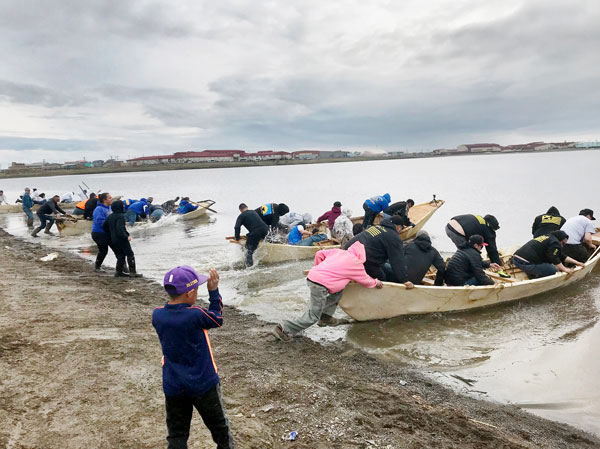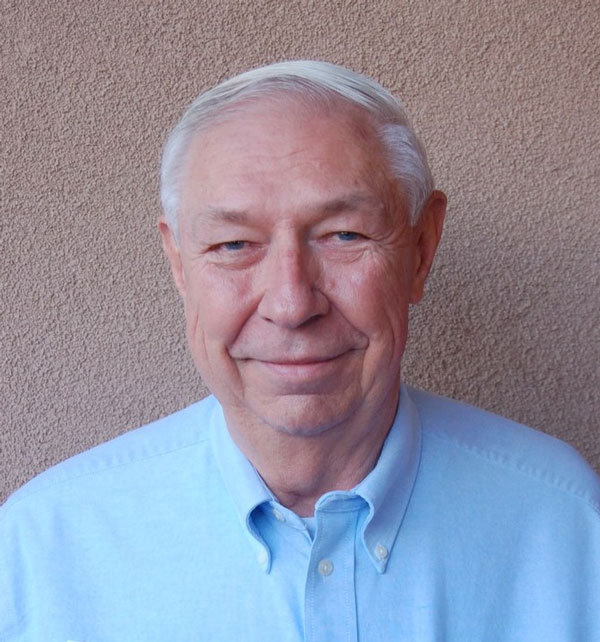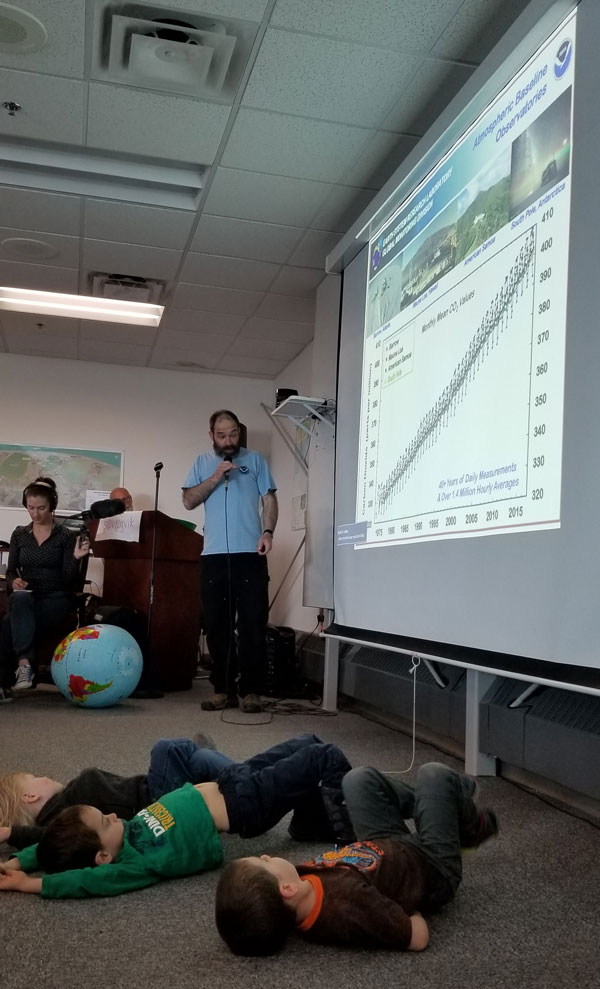
SKIN BOAT RACE — Four native crews, in four seal-skin boats used in the community’s spring whale hunt, prepare to race for a prize of gasoline. Usually held on July 4, the race was postponed due to bad weather and rescheduled so it would be part of the festivities at the Atmospheric Radiation Measurement center barbecue. The boats launched, raced across the central lagoon in Barrow, Alaska, touched an observer on the far side, then rowed back. First boat to land at the launch point won. (Photo by Mark Ivey)
A community barbecue featuring science talks, door prizes and even boat races celebrated 20 years of research on the changing Arctic climate in mid-July for the Sandia-managed Atmospheric Radiation Measurement Center in Utqiaġvik (formerly Barrow), Alaska.
An overflow local crowd learned how scientists have used ARM’s capabilities to deploy airplanes, ships, balloons and most recently drones to gather extensive data on Arctic atmospheric conditions and processes. Phenomena studied include cloud formation, atmospheric ice formation, radiation — blocked, reflected or absorbed — snow and rainfall, wind conditions and changes at various levels of the oceans’ shallow and deep currents.
Door prizes provided by private donors were geared for an intrepid crowd: a GPS device, a camping solar-panel charger, a Coleman stove, a thermos, an LED headlamp and a quadcopter drone, so-called due to its four propellers.
“We worked with our colleagues at the Alaska native corporation UIC Science (Ukpeaġvik Iñupiat Corp) on the event,” said Mark Ivey, Sandia manager of the ARM site. “A terrific fellow named Kaare Erickson from UIC cooked hamburgers and hotdogs — not whale meat, sorry.”
Arctic amplifies climate changes

Interest continues in northernmost North America because, explained Bernie Zak, retired Sandia researcher and ARM’s initial manager, “Changes in climate are amplified in the Arctic.”
Bernie, who was tapped by current site manager Mark Ivey to be a featured speaker at the celebration, said there’s a dramatic difference in Earth’s heat absorption when ice and snow, which reflect heat, melt and vanish. Only water and earth — both good heat absorbers — remain to take their place.
Also soot, which flies all over the world as fine particles, or aerosols, has a larger heat-absorption effect when it lands on
the Arctic’s white snow and ice than on the already dark earth and water of the lower latitudes. “In the Arctic, it’s a magnified effect: as the level of snow melts, the recent soot gets added to the old soot below it, and the surface gets darker and darker,” he said.
Bernie is credited with helping to give birth to and then guide the Alaskan ARM facility in Utquagvik — the most northern of several ARM sites funded by DOE — over its first decade.
Bernie graduated first in his class in physics in 1963 from DePaul University in Chicago and earned a doctorate in the same subject from the University of California, Berkeley in 1971. His climate research path began after a three-year stint at Lawrence Berkeley National Laboratory, when he came to Sandia to work with hazardous aerosols and air pollution. In the 1980s, his focus migrated slightly to study the concept of nuclear winter, which postulated that “if there were ever a global nuclear war, there would be so much dust and smoke launched into the atmosphere, there’d be no summer for maybe two or three years,” Bernie said.
National security interests
In that case, he continued, “the northern hemisphere would lose more population from starvation than from the weapons. So, the condition was of interest to Sandia as a national security threat.”
From there, “it was a relatively easy transition into the climate program,” he said, and when DOE solicited applications in 1991 for people to head up the three ARM sites, he was chosen to head the northern site.
But before work began, “there was a hiatus,” he said. “There was no funding to proceed.”
That situation changed in 1996 when the DOE provided funds to proceed with the development and operation of what became the DOE North Slope of Alaska ARM facility. This coincided with the National Science Foundation’s initiation of the Surface Heat Budget of the Arctic project, which was joined by multiple agencies and universities. SHEBA involved the year-long drift of an instrumented icebreaker rented from the Canadian government and intentionally frozen into the Arctic ice pack.
Thinning ice pack
“The intent was to freeze the ship into ice a meter thick, but it had been decades since anyone took a serious look at the Arctic ice pack,” said Bernie. “It was hard to find ice a half-meter thick.” So study of the Arctic became “hot,” he said, “because we were observing changes long predicted in climate models.”
The icebreaker’s screw propellers were turned off, but the ship remained powered for heat and light. Scientists flew in and out by helicopter, working to determine the condition of the ocean at various levels as well as wind and other atmospheric phenomena.
“So we received funding from DOE to implement the Alaskan ARM program, and we established the research station at Utquagvik as a support site,” Bernie said. “It wasn’t planned as a pre-eminent facility, but that’s the way it’s been working out. It allowed us to observe changes that provided data for our models to forecast future changes,” Bernie said.
Data supported projections
“It was gratifying that data coming in were supportive of projections that had been made of changes in the Arctic, although we were surprised at the rapidity with which this was taking place,” he added. “There was shrinkage of snow coverage; it disappeared earlier in spring and returned later in fall.”
In addition to Bernie, presentations were made by Alistair Rogers of Brookhaven National Laboratory and Bryan Thomas from the National Oceanic and Atmospheric Administration and the Barrow Observatory.
“Hans Verlinde (of ARM and Penn State University) also gave a wonderful presentation about arctic clouds,” said Mark.
Mark, who took over management of the site for Sandia in 2010 when Bernie retired, honored Walter Brower, ARM facility site manager and Jimmy Ivanoff, ARM chief operator, both from UIC, along with Verlinde for almost 20 years of service to ARM, and they received warm applause from the crowd.
Mark said, “We were very glad for the big turnout and hope to do similar events in the future. I’d like to mention that without the support of the native community in Utquagvik, where we are guests, scientific work would not be possible. They have actually set aside a large tract of land for long-term environmental studies, and they are very interested in the outcomes of programs like ours.”

Upcoming is another icebreaker deployment for scientific observation, which Mark said is planned for next year as part of the NSF’s MOSAIC, or Multidisciplinary drifting Observatory for the Study of Arctic Climate, a multi-national, multi-agency campaign.